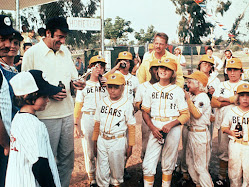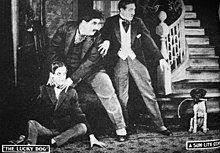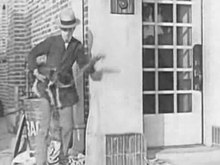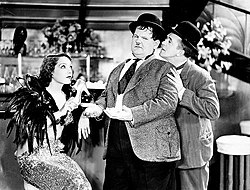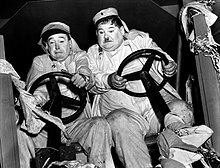Laurel and Hardy were a comedy
double act during the
early Classical Hollywood era of
American cinema. The team was composed of English thin man
Stan Laurel (1890–1965) and American fat man
Oliver Hardy (1892–1957). They became well known during the late 1920s through the mid-1940s for their
slapstick comedy, with Laurel playing the clumsy and childlike friend of the pompous bully Hardy.
]The duo's signature tune is known variously as "The Cuckoo Song",
"Ku-Ku", or "The Dance of the Cuckoos". It was played over the opening
credits of their films and has become as emblematic of the duo as their
bowler hats.
Prior to emerging as a team, both actors had well-established film
careers. Laurel had appeared in over 50 films while Hardy had been in
more than 250 productions. The two comedians had previously worked
together as cast members on the film
The Lucky Dog
in 1921. However, they were not a comedy team at that time and it was
not until 1926 that they appeared in a movie short together, when both
separately signed contracts with the
Hal Roach film studio. Laurel and Hardy officially became a team in 1927 when they appeared together in the silent short film
Putting Pants on Philip. They remained with the Roach studio until 1940 and then appeared in eight
"B" movie comedies for
20th Century Fox and
Metro-Goldwyn-Mayer from 1941 to 1945.
[
After finishing their movie commitments at the end of 1944, they
concentrated on performing in stage shows and embarked on a music hall
tour of England, Ireland, and Scotland
. In 1950, before retiring from the screen, they made their last film, a
French/
Italian co-production called
Atoll K.
They appeared as a team in 107 films, starring in 32 short
silent films, 40 short
sound films, and 23 full-length
feature films. They also made 12 guest or
cameo appearances that included the
Galaxy of Stars promotional film of 1936. On December 1, 1954, the pair made one American television appearance when they were surprised and interviewed by
Ralph Edwards on his live NBC-TV program
This Is Your Life.
Since the 1930s, the works of Laurel and Hardy have been released in
numerous theatrical reissues, television revivals, 8-mm and 16-mm home
movies, feature-film compilations, and home videos. In 2005, they were
voted the seventh-greatest comedy act of all time by a UK poll of fellow
comedians. The official Laurel and Hardy appreciation society is known as
The Sons of the Desert which was named after a fictitious
fraternal society featured in the Laurel and Hardy
film of the same name.
Early careers
Stan Laurel
Stan Laurel (June 16, 1890 – February 23, 1965) was born Arthur Stanley Jefferson in
Ulverston, Lancashire (today Cumbria), England into a theatrical family. His father Arthur Joseph Jefferson was a theatrical entrepreneur and
theatre owner in northern England and Scotland who, together with his
wife, was a major force in the industry. In 1905, the Jefferson family moved to
Glasgow to be closer to their business mainstay of the Metropole Theatre, and Laurel made his stage debut in a Glasgow hall called the
Britannia Panopticon one month short of his 16th birthday.
Arthur Jefferson secured Laurel his first acting job with the juvenile
theatrical company of Levy and Cardwell, which specialized in Christmas
Pantomimes.
]ng actor, and as an
understudy for
Charlie Chaplin.Laurel said of Karno, "There was no one like him. He had no equal. His name
was box-office."
[
In 1912, Laurel left England with the Fred Karno Troupe to tour the
United States. Laurel had expected the tour to be merely a pleasant
interval before returning to London; however, he migrated to the U.S.
during the trip.
[ In 1917, Laurel was teamed with
Mae Dahlberg as a
double act for stage and film; they were living as
common law husband and wife.
[ The same year, Laurel made his film debut with Dahlberg in
Nuts in May. While working with Mae, he began using the name "Stan Laurel" and changed his name legally in 1931.
[
Dahlberg held Laurel's career back because she demanded roles in his
films, and her tempestuous nature made her difficult to work with.
Dressing room arguments were common between the two; it was reported
that producer
Joe Rock paid her to leave Laurel and to return to her native
Australia.
[
In 1925, Laurel joined the Hal Roach film studio as a director and
writer. From May 1925 until September 1926, he received credit in at
least 22 films. Laurel starred in over 50 films for various producers before teaming up with Hardy.
[
Prior to that, he experienced only modest success. It was difficult for
producers, writers, and directors to write for his character, with
American audiences knowing him either as a "nutty
burglar" or as a
Charlie Chaplin imitator.
[
Oliver Hardy
Oliver Hardy (January 18, 1892 – August 7, 1957) was born Norvell Hardy in
Harlem, Georgia. By his late teens, Hardy was a popular stage singer and he operated a movie house in
Milledgeville, Georgia, the Palace Theater, financed in part by his mother. For his
stage name, he took his father's first name calling himself "Oliver Norvell Hardy" while offscreen his nicknames were "Ollie" and "Babe". The nickname "Babe" originated from an Italian barber near the
Lubin Studios in
Jacksonville, Florida
who would rub Hardy's face with talcum powder and say "That's nice-a
baby!" Other actors in the Lubin company mimicked this and Hardy was
billed as "Babe Hardy" in his early films.
Seeing film comedies inspired an urge to take up comedy himself and,
in 1913, he began working with Lubin Motion Pictures in Jacksonville. He
started by helping around the studio with lights, props, and other
duties, gradually learning the craft as a script-clerk for the company.
[ It was around this time that Hardy married his first wife Madelyn Salosihn. In 1914, Hardy was billed as "Babe Hardy" in his first film,
Outwitting Dad. Between 1914 and 1916 Hardy made 177
shorts as Babe with the
Vim Comedy Company that were released up to the end of 1917.
Exhibiting a versatility in playing heroes, villains and even female
characters, Hardy was in demand for roles as a supporting actor, comic
villain or
second banana. For 10 years he memorably assisted star comic and Charlie Chaplin imitator
Billy West,
Jimmy Aubrey,
Larry Semon, and
Charley Chase.
In total, Hardy starred or co-starred in more than 250 silent shorts of
which roughly 150 have been lost. He was rejected for enlistment by the
Army during World War I due to his size. In 1917, after the collapse of
the Florida film industry, Hardy and his wife Madelyn moved to
California to seek new opportunities.
History as Laurel and Hardy
Style of comedy and characterizations
The humor of Laurel and Hardy was highly visual with slapstick used for emphasis. They often had physical arguments with each other (in character), which were quite complex and involved
cartoon violence,
and their characters precluded them from making any real progress in
the simplest endeavors. Much of their comedy involves milking a joke,
where a simple idea provides a basis from which to build multiple gags
without following a defined
narrative.
Stan Laurel was of average height and weight, but appeared small and
slight next to Oliver Hardy, who was 6 ft 1 in (185 cm) tall
and weighed about 280 lb (127 kg) in his prime. They used some details
to enhance this natural contrast. Laurel kept his hair short on the
sides and back, growing it long on top to create a natural "fright wig".
At times of shock, he would simultaneously cry while pulling up his
hair. In contrast, Hardy's thinning hair was pasted on his forehead in
spit curls and he sported a
toothbrush moustache. To achieve a flat-footed walk, Laurel removed the heels from his shoes. Both wore
bowler hats, with Laurel's being narrower than Hardy's, and with a flattened brim. The characters' normal attire called for
wing collar shirts, with Hardy wearing a neck tie which he would twiddle and Laurel a
bow tie. Hardy's
sports jacket was a tad small and done up with one straining button, whereas Laurel's
double-breasted jacket was loose fitting.
A popular routine the team performed was a "
tit-for-tat" fight with an adversary. This could be with their wives—often played by
Mae Busch,
Anita Garvin, or
Daphne Pollard—or with a neighbor, often played by
Charlie Hall or
James Finlayson. Laurel and Hardy would accidentally damage someone's property, with the injured party
retaliating by ruining something belonging to Laurel or Hardy.
After calmly surveying the damage, they would find something else to
vandalize, and conflict would escalate until both sides were
simultaneously destroying items in front of each other. An early example of the routine occurs in their classic short,
Big Business (1929), which was added to the
National Film Registry in 1992. Another short film which revolves around such an altercation was titled
Tit for Tat (1935).
One best-remembered dialogue was the "Tell me that again" routine.
Laurel would tell Hardy a genuinely smart idea he came up with, and
Hardy would reply, "Tell me that again." Laurel would attempt to repeat
the idea, but babble utter nonsense. Hardy, who had difficulty
understanding Laurel's idea even when expressed clearly, would
understand perfectly when hearing the jumbled version. While much of
their comedy remained visual, various lines of humorous dialogue
appeared in Laurel and Hardy's talking films. Some examples include:
- "You can lead a horse to water but a pencil must be led." (Laurel, Brats)
- "I was dreaming I was awake but I woke up and found meself asleep." (Laurel, Oliver the Eighth)
- "A lot of weather we've been having lately." (Hardy, Way Out West)
In some cases, their comedy bordered on the surreal, in a style that Stan Laurel called "white magic". For example, in the 1937 film
Way Out West, Laurel clenches his fist and pours tobacco into it as if it were a pipe. He then flicks his thumb upward as if working a
lighter.
His thumb ignites and he matter-of-factly lights his "pipe". The amazed
Hardy, seeing this, would unsuccessfully attempt to duplicate it
throughout the film. Much later Hardy finally succeeds, only to be
terrified when his thumb catches fire. Laurel repeats the pipe joke in
the 1938 film
Block-Heads,
again to Hardy's bemusement. The joke ends, this time with a match
Laurel was using, relighting itself, which Hardy throws into the
fireplace, whereupon it explodes with a loud bang.
Rather than showing Hardy suffering the pain of misfortunes, such as
falling down stairs or being beaten by a thug, banging and crashing
sound effects were often used so the audience could visualize the scene
for themselves. The 1927 film
Sailors Beware
was a significant film for Hardy because two of his enduring trademarks
were developed. The first was his "tie-twiddle" to demonstrate
embarrassment.
[
Hardy, while acting, had been met with a pail of water in the face. He
said, "I had been expecting it, but I didn't expect it at that
particular moment. It threw me mentally and I couldn't think what to do
next, so I waved the tie in a kind of tiddly-widdly fashion to show
embarrassment while trying to look friendly." His second trademark was the "camera look" in which he breaks the
fourth wall.Hardy said: "I had to become exasperated so I just stared right into the camera and registered my disgust."
[
Offscreen Stan Laurel and Oliver Hardy were quite the opposite of their
movie characters: Laurel was the industrious "idea man" while Hardy was
more easygoing.
Catchphrases
The catchphrase most used by Laurel and Hardy on film is: "Well, here's another nice mess you've gotten me into!" The phrase was earlier used by
W. S. Gilbert in both
The Mikado from 1885 and
The Grand Duke from 1896. It was first used by Hardy in
The Laurel-Hardy Murder Case in 1930. In popular culture the catchphrase is often misquoted as "Well, here's another
fine
mess you've gotten me into." The misquoted version of the phrase was
never used by Hardy and the misunderstanding stems from the title of
their film
Another Fine Mess.Numerous variations of the quote appeared on film. For example, in
Chickens Come Home Ollie says impatiently to Stan "Well...." with Stan replying, "Here's another nice mess I've gotten you into." The films
Thicker than Water and
The Fixer-Uppers use the phrase "Well, here's another nice kettle of fish you pickled me in!" In
Saps at Sea the phrase becomes "Well, here's another nice bucket of suds you've gotten me into!"
Another regular catchphrase, cried out by Ollie in moments of
distress or frustration, as Stan stands helplessly by, is "Why don't you
do something to
help me?" And another, not-as-often used
catchphrase of Ollie, particularly after Stan has accidentally given a
verbal idea to an adversary of theirs to torment them even more: "Why
don't you keep your (big) mouth shut?!"
"D'oh!" was a catchphrase used by the mustachioed Scottish actor
James Finlayson who appeared in 33 Laurel and Hardy films.
[ The phrase, expressing surprise, impatience, or incredulity, was the inspiration for "
D'oh!" as spoken by the actor Dan Castelleneta portraying the character
Homer Simpson in the long-running animated comedy
The Simpsons. Homer's first intentional use of "d'oh!" occurred in the Ullman short "Punching Bag" (1988).
Films
Laurel and Hardy appeared for the first time together in
The Lucky Dog (1921).
The first film pairing of the two, although as separate performers, took place in the silent film
The Lucky Dog
in 1921. The exact date the film was produced is not recorded but film
historian Bo Bergulund dated it between late 1920 and January 1921. The association was casual, according to interviews given in the 1930s, and both of them had forgotten it entirely.
The plot sees Laurel's character befriended by a stray dog which, after
some lucky escapes, saves him from being blown up by dynamite. Hardy's
character is a mugger attempting to rob Laurel. Several years later both comedians separately signed with the Hal Roach film studio and next appeared in the 1926 film
45 Minutes From Hollywood.
Hal Roach was considered to be the most important person in the
development of their film careers. He brought the team together and they
worked for Hal Roach Studios for over 20 years.
[Charley Rogers
worked closely with the three men for many years and said, "It could
not have happened if Laurel, Hardy and Roach had not met at the right
place and the right time."
[Their first "official" film together as a team was the 1927 film
Putting Pants on Philip. The plot involves Laurel as Philip, a young Scots man newly arrived in the United States, in full
kilted splendor, suffering mishaps involving the kilt. His uncle, played by Hardy, is shown trying to put trousers on him. Also, in 1927, the pair starred in
The Battle of the Century, a lost but now found classic short, which involved over 3,000 cream pies.
Laurel said to the duo's biographer
John McCabe:
"Of all the questions we're asked, the most frequent is how did we come
together? I always explain that we came together naturally." Laurel and Hardy were joined by accident and grew by indirection.
In 1926, both were part of the Roach Comedy All Stars which was a group
of actors of similar standing who took part in a series of films. Quite
unwittingly Laurel and Hardy's parts grew larger while those of their
fellow stars diminished because Laurel and Hardy were considered to be
great actors. Their teaming up was suggested by
Leo McCarey
who was their supervising director from 1927 and 1930. It was during
this period that McCarey and Laurel jointly devised the team's format.
McCarey also influenced the slowing down of their comedy to a more
natural pace. After teaming up they played the same characters for 30
years.
Although Hal Roach employed writers and directors such as
H. M. Walker,
Leo McCarey,
James Parrott and
James W. Horne
on the Laurel and Hardy films, Laurel would rewrite entire sequences or
scripts. He would also have the cast and crew improvise on the sound
stage; he would then meticulously review the footage during the editing
process.
[
By 1929 Laurel was the head writer and it was reported that the writing
sessions were gleefully chaotic. Stan had three or four writers who
joined in a perpetual game of
'Can You Top This?'
As Laurel obviously relished writing gags, Hardy was more than happy to
leave the job to his partner and was once quoted as saying "After all,
just doing the gags was hard enough work, especially if you have taken
as many falls and been dumped in as many mudholes as I have. I think I
earned my money".
From this point, Laurel was an uncredited film director for their
films. He ran the Laurel and Hardy set, no matter who was in the
director's chair, but never felt compelled to assert his authority.
Roach remarked: "Laurel bossed the production. With any director, if
Laurel said 'I don't like this idea,' the director didn't say 'Well,
you're going to do it anyway.' That was understood." As Laurel made so many suggestions there was not much left for the credited director to do.
In 1929 the
silent era of film was coming to an end, and many actors saw their careers decline with the advent of sound.
[ Many silent film actors failed to make the transition because they
decided their prime duty was to tell stories in words or they
overemphasized their speech. Laurel and Hardy avoided this pitfall
because the
As a team they proved skillful in their melding of visual and verbal
humor and made a seamless transition to the talking era in their first
sound film
Unaccustomed As We Are from 1929.
[ The title took its name from the familiar phrase "Unaccustomed as we are to public speaking". In the opening dialogue, Laurel and Hardy began by
spoofing the slow and self-conscious speech of the early talking actors which became a routine they would use regularly.
The first feature film starring Laurel and Hardy was
Pardon Us from 1931.
[ The following year
The Music Box, whose plot revolved around the pair pushing a piano up a long flight of steps,
[ won an
Academy Award for Best Live Action Short Subject
] While many enthusiasts claim the superiority of
The Music Box, their 1929 silent film
Big Business is by far the most consistently acclaimed.
The plot of this film sees Laurel and Hardy as Christmas tree salesman
involved in a classic tit-for-tat battle with a character played by
James Finlayson that eventually destroys his house and their car
Big Business was added to the
National Film Registry in the United States as a national treasure in 1992. The film
Sons of the Desert from 1933 is often claimed to be Laurel and Hardy's best feature-length film.A number of their films were reshot with Laurel and Hardy speaking in Spanish, Italian, French or German.
The plots for these films were similar to the English-language version
although the supporting cast were often native language speaking actors.
While Laurel and Hardy could not speak these foreign languages they
received voice coaching for their lines. The film
Pardon Us from 1931 was re shot in all four foreign languages while the films
Blotto,
Hog Wild and
Be Big! were made in French and Spanish versions.
Night Owls was made in both Spanish and Italian and
Below Zero along with
Chickens Come Home were only made in Spanish.
Laurel and Hardy in their final film,
Atoll K (1951)
The 1934 film
Babes in Toyland remains a perennial on American television during the Christmas season.
When interviewed Hal Roach spoke scathingly about the film and Laurel's
behavior during the production. Laurel was unhappy with the plot, and
after an argument was allowed to make the film his way.The rift damaged Roach-Laurel relations to the point that Roach said that after
Toyland, he no longer wished to produce Laurel and Hardy films. Nevertheless, their association continued for another six years. Hoping for greater artistic freedom, Laurel and Hardy split with Roach and signed with
20th Century-Fox and
Metro-Goldwyn-Mayer. However, the working conditions were now completely different as they
were hired simply as actors, relegated to the B-film divisions, and were
initially not allowed to improvise or contribute to the scripts.
When the films proved popular the studios allowed the team more input
and Laurel and Hardy starred in eight features until 1944. These films,
while not considered the team's best work, were financially very
successful. The films, budgeted between $250,000 and $300,000 each,
earned millions at the box office. The Fox films were so profitable that
the studio kept making Laurel and Hardy comedies after Fox discontinued
its other "B" series films.
In 1951, Laurel and Hardy made their final feature-length film together,
Atoll K. This film was a French-Italian co-production directed by
Leo Joannon, but was plagued by problems with language barriers, production issues, and the serious health issues of both Laurel and Hardy.
During the filming, Hardy began to lose weight precipitously and
developed an irregular heartbeat. Laurel was experiencing painful
prostate complications as well. Critics were disappointed with the storyline, English dubbing and Laurel's sickly physical appearance in the film. The film was not a success and it brought an end to Laurel and Hardy's film careers.
[ Most Laurel and Hardy films have survived and have not gone out of
circulation permanently. Three of their 107 films are considered
lost and have not been seen in their complete form since the 1930s. The silent film
Hats Off from 1927 has vanished completely. The first half of the 1927 film
Now I'll Tell One is lost and the second half has yet to be released on video. In the 1930 operatic Technicolor musical
The Rogue Song, Laurel and Hardy appear in 10 sequences and only one of which is known to exist with the complete soundtrack.
Final years
Following the making of
Atoll K,
Laurel and Hardy took some months off, allowing Laurel to recuperate.
Upon their return to the European stage in 1952, they undertook a
well-received series of public appearances, performing a short sketch
Laurel had written called "A Spot of Trouble". Hoping to repeat the
success the following year Laurel wrote a routine entitled "Birds of a
Feather". On September 9, 1953, their boat arrived in
Cobh in the
Republic of Ireland. Laurel recounted their reception:
The love and affection we found that day at Cobh was simply
unbelievable. There were hundreds of boats blowing whistles and mobs and
mobs of people screaming on the docks. We just couldn't understand what
it was all about. And then something happened that I can never forget.
All the church bells in Cobh started to ring out our theme song "Dance
of the Cuckoos" and Babe (Oliver Hardy) looked at me and we cried. I'll
never forget that day. Never.
While on tour of the British Isles in 1953, Stan and Babe appeared on
radio in Ireland and on a live BBC television broadcast of the popular
show
Face the Music with host Henry Hall a week later.
Unfortunately, these shows do not appear to have been preserved on
record, tape or kinescope, but notes from the
Face The Music
television appearance have been recently discovered. According to the
notes, Ollie informs Stan that the television program has an audience of
six million and that host Henry Hall is "going to introduce us to
them". To which Stan replies "That's going to take a long time, isn't
it?"
On December 1, 1954, the team made their only American television appearance when they were surprised and interviewed by
Ralph Edwards on his live NBC-TV program
This Is Your Life. Lured to the Knickerbocker Hotel as a subterfuge for a business meeting with producer
Bernard Delfont the doors opened to their suite #205, flooding the room with light and the voice of Edwards. This telecast was preserved on a
kinescope
and later released on home video. Partly due to the positive response
from the television broadcast the pair was renegotiating with Hal Roach,
Jr. for a series of color
NBC Television specials to be called
Laurel and Hardy's Fabulous Fables. However, plans for the specials had to be shelved as the aging comedians continued to suffer from declining health. In 1955, Laurel and Hardy made their final public appearance together while taking part in the program
This Is Music Hall. This was a
BBC Television program about the
Grand Order of Water Rats,
a British variety organization. Laurel and Hardy provided a filmed
insert in which they reminisce about their friends in British variety.
They made their final appearance on camera in 1956 in a private home
movie, shot by a family friend at the Reseda, CA home of Stan Laurel‘s
daughter, Lois. It contains no audio and is three minutes in length.
In 1956, while following his doctor's orders to improve his health
due to a heart condition, Hardy lost over 100 pounds (45 kg; 7.1 st).
However, he suffered several strokes that resulted in the loss of
mobility and speech. Despite having a long and successful career, it was
reported that Hardy's home was sold to help cover the cost of his
medical expenses during this time. He died of a stroke on August 7, 1957, and longtime friend Bob
Chatterton stated that Hardy weighed just 138 pounds (63 kg; 9.9 st) at
the time of his death. Hardy was laid to rest at Pierce Brothers
Valhalla Memorial Park, North Hollywood. Following Hardy's death, Laurel and Hardy's films were returned to movie theaters as clips of their work were featured in
Robert Youngson's silent-film compilation
The Golden Age of Comedy.
For the remaining eight years of his life, Stan Laurel refused to perform and even turned down
Stanley Kramer's offer of a cameo in his landmark 1963 movie
It's a Mad, Mad, Mad, Mad World.
[85]
In 1960, Laurel was given a special Academy Award for his contributions
to film comedy but was unable to attend the ceremony, due to poor
health, and actor
Danny Kaye accepted the award for him. Despite not appearing onscreen after Hardy's death, Laurel did
contribute gags to several comedy filmmakers. During this period most of
his communication was in the form of written correspondence and he
insisted on answering every fan letter personally. Late in life, he hosted visitors of the new generation of comedians and celebrities including
Dick Cavett,
Jerry Lewis,
Peter Sellers,
Marcel Marceau, and
Dick Van Dyke.
[
Laurel lived until 1965 and survived to see the duo's work rediscovered
through television and classic film revivals. He died on February 23 in
Santa Monica and is buried at
Forest Lawn-Hollywood Hills in
Los Angeles, California.



